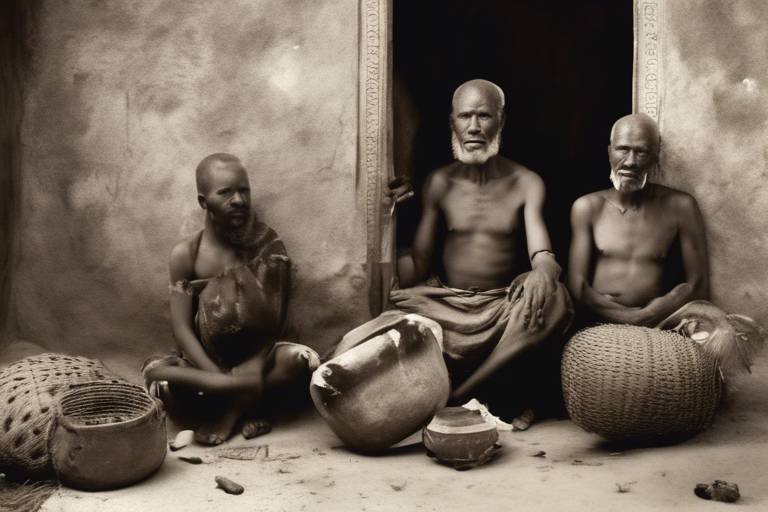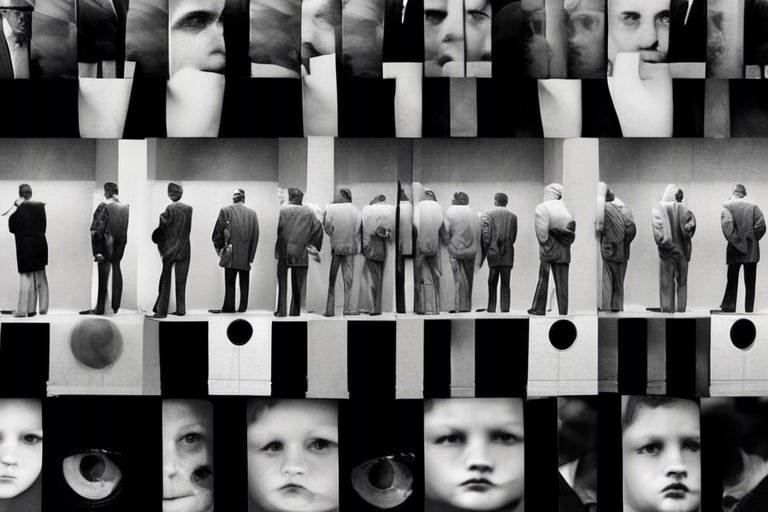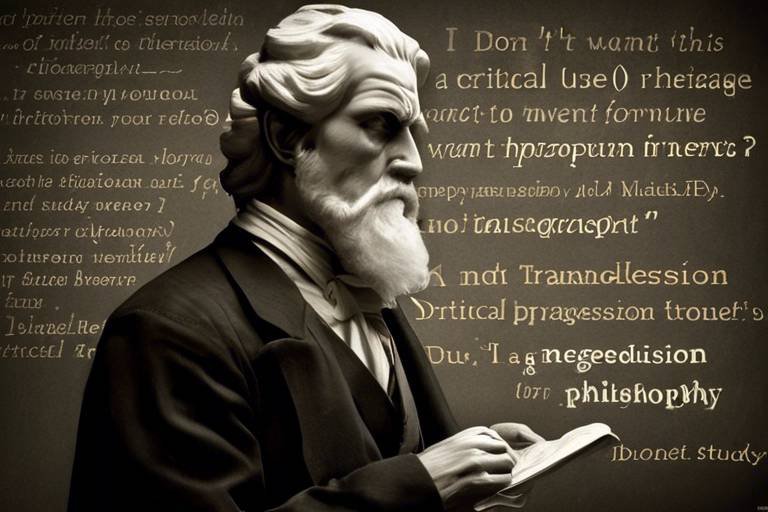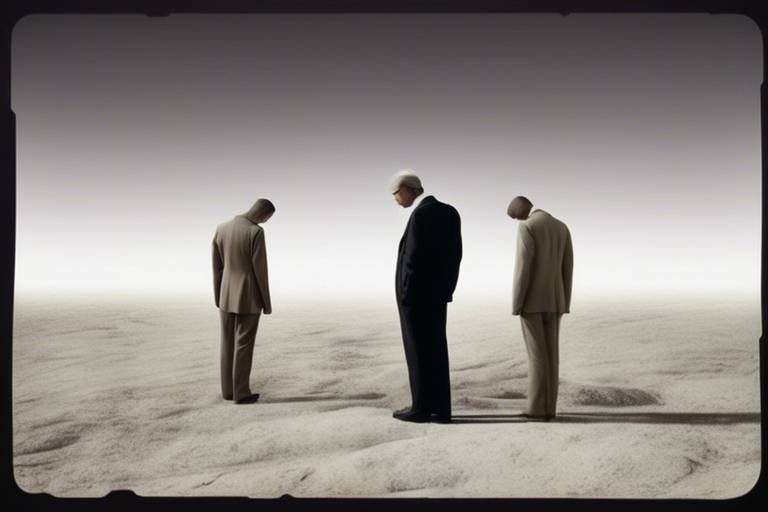What is Postmodernism – A Philosophical Review
Postmodernism is a term that often stirs up a whirlwind of thoughts and emotions. It’s like trying to catch smoke with your bare hands—elusive and complex. At its core, postmodernism is a philosophical movement that emerged in the mid-20th century as a reaction against the certainties of modernism. Imagine standing at a crossroads where traditional values and grand narratives collide with skepticism and relativism. That's where postmodernism thrives. It challenges the idea that there is a single, universal truth, suggesting instead that our understanding of reality is shaped by cultural, historical, and social contexts.
To fully grasp what postmodernism is, we need to explore some of its defining characteristics. One of its hallmark traits is a profound skepticism towards grand narratives—those overarching stories or ideologies that claim to explain everything, like religion or science. Postmodernists argue that these narratives often exclude alternative perspectives and marginalize certain voices. Think of it as a buffet where only a few dishes are served, leaving many others off the table. In this way, postmodernism embraces relativism, the idea that truth is not absolute but instead varies from one context to another. This perspective invites us to question everything we think we know, making it both liberating and disorienting.
The influence of postmodernism stretches across various fields, from art and literature to architecture and philosophy. It’s like a ripple effect, where the ideas of a few thinkers have transformed entire disciplines. In the realm of art, for instance, postmodernism encourages a playful mixing of styles and mediums, blurring the lines between high and low culture. Artists like Andy Warhol and Cindy Sherman exemplified this by challenging conventional notions of originality and authorship. Similarly, in literature, authors like Thomas Pynchon and Don DeLillo employ techniques such as metafiction and intertextuality, which invite readers to engage in a more active and questioning relationship with the text.
Yet, as intriguing as postmodernism may be, it is not without its critics. Detractors argue that its skepticism can lead to a form of nihilism, where nothing holds value or meaning. This raises important questions: If we can’t agree on what is true, how do we navigate moral landscapes? Can we build a cohesive society on shifting sands? These critiques highlight the tension inherent in postmodern thought, sparking vibrant debates that continue to this day.
In our increasingly digital world, postmodernism finds new expressions through technology. Social media platforms, for example, amplify the fragmented nature of identity and reality that postmodernists often discuss. Users curate their online personas, presenting a collage of selves that can shift from one moment to the next. This phenomenon reflects the postmodern idea that identity is not fixed but rather fluid and constructed through interactions and contexts.
Lastly, it’s essential to recognize that postmodernism is not just a Western phenomenon. Its ideas resonate globally, as cultures around the world interpret and adapt postmodern thought to their unique contexts. This global perspective enriches our understanding of postmodernism, illustrating that it’s a dynamic and evolving discourse rather than a static set of ideas.
- What is the main idea of postmodernism? Postmodernism questions the existence of universal truths and grand narratives, advocating for a more relativistic understanding of reality.
- Who are some key figures in postmodern philosophy? Influential thinkers include Jean-François Lyotard, Jacques Derrida, and Michel Foucault, each contributing unique perspectives to the movement.
- How does postmodernism influence art and literature? Postmodernism encourages experimentation and challenges traditional forms, leading to innovative expressions in both fields.
- What are some criticisms of postmodernism? Critics argue that its skepticism can lead to nihilism and moral relativism, raising questions about truth and ethics.
- Is postmodernism relevant today? Yes, especially in the context of digital culture and global perspectives, where its ideas continue to shape discussions on identity and reality.

Defining Postmodernism
Understanding postmodernism is like trying to catch smoke with your bare hands; it’s elusive, complex, and often defies straightforward definition. At its core, postmodernism is a reaction against the grand narratives and ideologies that dominated modernist thought. Think of it as a critical lens through which we examine the world, questioning the very foundations of knowledge, truth, and authority.
One of the defining characteristics of postmodernism is its inherent skepticism. It challenges the idea that there is a single, universal truth, instead proposing that truths are subjective and shaped by cultural, social, and historical contexts. This leads to a form of relativism where multiple perspectives are not only acknowledged but celebrated. In essence, postmodernism invites us to embrace contradictions and complexities rather than seek simple answers.
Moreover, postmodernism often employs irony and playfulness in its discourse, blurring the lines between high and low culture. This can be seen in various forms of media, from literature to art, where traditional boundaries are dismantled. For instance, a novel might mix genres or incorporate various narrative styles, reflecting the chaotic nature of contemporary life.
To illustrate the essence of postmodernism, consider the following table that outlines its key features:
| Feature | Description |
|---|---|
| Skepticism | Questioning the existence of objective truths. |
| Relativism | Embracing multiple perspectives and interpretations. |
| Ironic Playfulness | Utilizing humor and irony to critique established norms. |
| Intertextuality | Referencing and incorporating other texts within a work. |
In summary, postmodernism is not just a philosophical movement; it's a way of understanding the world that encourages us to question everything we thought we knew. It challenges us to look beyond the surface, to explore the layers of meaning that exist in our everyday lives. So, the next time you find yourself confronted with a complex issue, remember that postmodernism invites you to embrace the ambiguity and uncertainty rather than shy away from it.

Historical Context
To truly understand postmodernism, we must first take a step back and examine the historical backdrop that gave rise to this multifaceted movement. The roots of postmodern thought can be traced to the decline of modernism, a period characterized by a strong belief in progress, reason, and the power of science. As the twentieth century unfolded, significant events such as the World Wars, the Cold War, and the rise of technology began to challenge these modernist ideals. The optimism that once fueled the belief in a rational world started to wane, leading thinkers to question the validity of overarching narratives that claimed to explain the complexities of human experience.
In the aftermath of these tumultuous events, a cultural shift began to emerge, marked by a growing skepticism towards the grand narratives that had previously dominated Western thought. This skepticism paved the way for a more fragmented and pluralistic understanding of reality, where meaning became subjective and context-dependent. The decline of industrial society and the rise of consumer culture further contributed to this transformation, as individuals began to grapple with the effects of globalization and the explosion of information in the digital age.
During the mid to late twentieth century, several key cultural movements began to reflect and embody these postmodern sentiments. The 1960s counterculture, for instance, challenged traditional values and norms, embracing diversity and alternative lifestyles. This period saw the emergence of various artistic and intellectual movements that questioned established conventions, including feminism, civil rights, and environmentalism. These movements played a crucial role in shaping the postmodern landscape, as they advocated for marginalized voices and emphasized the importance of localized narratives.
Moreover, the rise of technology and mass media significantly influenced the postmodern condition. With the advent of television, the internet, and social media, the way we consume information and interact with one another transformed dramatically. This shift blurred the lines between reality and representation, leading to a culture where images and narratives are constantly recycled and reinterpreted. As a result, the distinction between high and low culture began to dissolve, giving rise to a more democratized and chaotic cultural landscape.
In summary, the historical context of postmodernism is deeply intertwined with the decline of modernist thought, the cultural upheavals of the twentieth century, and the transformative impact of technology. By examining these factors, we can gain a clearer understanding of how postmodernism emerged as a response to the complexities and contradictions of contemporary life, challenging us to rethink our assumptions about truth, identity, and the nature of reality itself.
- What is the main difference between modernism and postmodernism? Modernism is characterized by a belief in objective truth and linear narratives, while postmodernism embraces skepticism and relativism, questioning the validity of grand narratives.
- Who are some key figures in postmodern philosophy? Notable philosophers include Jean-François Lyotard, Jacques Derrida, and Michel Foucault, each contributing unique perspectives to the postmodern discourse.
- How does postmodernism influence contemporary art? Postmodernism challenges traditional artistic conventions, encouraging artists to experiment with form, style, and meaning, often blurring the lines between different genres and media.
- Is postmodernism relevant today? Yes, postmodernism continues to influence various fields, including literature, art, and technology, as it addresses the complexities of identity, culture, and communication in a rapidly changing world.

Key Philosophers
When we dive into the world of postmodernism, we can't overlook the profound influence of several key philosophers who have shaped its landscape. Think of these thinkers as the architects of a new intellectual structure, each contributing unique ideas that challenge our understanding of reality, knowledge, and truth. Among them, Jean-François Lyotard, Jacques Derrida, and Michel Foucault stand out as pivotal figures whose works continue to resonate across various disciplines.
Jean-François Lyotard is often credited with coining the term "postmodernism" in his seminal work, The Postmodern Condition. He famously argued against the idea of grand narratives—those overarching stories that claim to explain history and human experience. Instead, Lyotard emphasized the importance of local narratives, suggesting that knowledge is not universal but rather fragmented and context-dependent. His skepticism towards metanarratives invites us to question the validity of what we consider 'truth,' making space for multiple perspectives and interpretations.
Next, we have Jacques Derrida, whose concept of deconstruction revolutionized literary theory and philosophy. Derrida challenged the idea that language can convey meaning in a straightforward manner. He argued that words are slippery, often leading to multiple interpretations rather than a single, clear message. This notion of playfulness in language reflects the postmodern spirit, as it encourages readers to engage actively with texts, unraveling layers of meaning rather than passively consuming information. Derrida’s work invites us to embrace ambiguity and uncertainty, which are hallmarks of postmodern thought.
Then there's Michel Foucault, a thinker whose exploration of power dynamics and knowledge profoundly impacted postmodern philosophy. Foucault argued that knowledge is not merely a tool for understanding the world but is also intertwined with power structures. His analyses of institutions, such as prisons and asylums, reveal how societal norms shape our understanding of reality. By examining the relationship between power and knowledge, Foucault encourages us to question who holds authority in defining truth and how that authority is maintained. His ideas challenge us to think critically about the systems that govern our lives.
These philosophers not only provide theoretical frameworks for understanding postmodernism but also provoke us to reflect on our own beliefs and assumptions. Their contributions can be summarized in the following table:
| Philosopher | Key Contribution | Notable Work |
|---|---|---|
| Jean-François Lyotard | Critique of grand narratives | The Postmodern Condition |
| Jacques Derrida | Deconstruction of language | Of Grammatology |
| Michel Foucault | Power/knowledge relationship | Discipline and Punish |
In summary, the contributions of these key philosophers are vital to understanding postmodernism. Their ideas not only challenge traditional views but also open up new avenues for thought and discussion. By engaging with their works, we can better appreciate the complexities of postmodernism and its implications for various fields, from literature and art to politics and technology.
- What is postmodernism? Postmodernism is a philosophical movement characterized by skepticism towards grand narratives, embracing relativism, and questioning established truths.
- Who are the key philosophers associated with postmodernism? Key philosophers include Jean-François Lyotard, Jacques Derrida, and Michel Foucault, each contributing unique perspectives to postmodern thought.
- How does postmodernism affect art and literature? Postmodernism challenges traditional forms and conventions, leading to innovative expressions in art and literature that often play with narrative structures and meanings.
- What are the critiques of postmodernism? Critics argue that postmodernism can lead to relativism and a lack of commitment to truth and morality, raising concerns about its implications for society.

Postmodernism in Art
Postmodernism in art is like a thrilling rollercoaster ride through the complexities of creativity, where traditional boundaries are not just blurred but often completely shattered. Imagine stepping into a world where the rules of art are rewritten, and the very essence of what art can be is constantly questioned. This movement emerged as a reaction against the rigid structures of modernism, embracing a playful, often ironic approach to artistic expression. Artists began to explore themes of fragmentation, plurality, and ambiguity, leading to a vibrant yet chaotic tapestry of styles and ideas.
One of the defining characteristics of postmodern art is its rejection of the notion that art must adhere to a specific set of principles or aesthetics. Instead, it celebrates diversity and inclusivity, allowing artists to draw inspiration from various sources, cultures, and historical periods. This eclecticism is vividly illustrated in the works of artists like Andy Warhol, whose use of commercial imagery and mass production techniques challenged the very notion of originality. Warhol's famous Campbell's Soup Cans are not just paintings; they are a commentary on consumer culture, blurring the lines between art and everyday life.
Moreover, postmodern art often employs a technique known as intertextuality, where artists reference or incorporate elements from other works of art, literature, or popular culture. This creates a rich dialogue between different forms of expression, inviting viewers to engage with the artwork on multiple levels. For instance, the work of Jean-Michel Basquiat combines elements of graffiti, symbolism, and historical references, creating a powerful narrative about identity and social issues.
In addition to visual art, postmodernism has significantly impacted other artistic domains, such as architecture and performance art. Architects like Frank Gehry and Zaha Hadid have embraced postmodern principles, creating buildings that defy conventional forms and challenge the viewer's perception of space. Gehry's Guggenheim Museum in Bilbao, Spain, is a stunning example of how postmodern architecture can evoke emotion and provoke thought through its unconventional shapes and materials.
Performance art has also flourished under the postmodern umbrella, with artists like Marina Abramović pushing the boundaries of what constitutes art. Her works often involve the body as a medium, exploring themes of endurance, vulnerability, and the relationship between the artist and the audience. This engagement blurs the line between performer and spectator, making art a shared experience that is as much about the process as it is about the final product.
As we dive deeper into the impact of postmodernism on art, it becomes clear that this movement is not merely a trend but a profound shift in how we understand and appreciate creativity. It encourages us to question our assumptions about art, to embrace the chaotic beauty of life, and to recognize that meaning is often subjective and multifaceted. In a world that is increasingly interconnected and complex, postmodern art serves as a mirror reflecting the diverse experiences and perspectives that shape our reality.
To summarize, postmodernism in art is characterized by:
- Eclecticism: A mix of styles, techniques, and influences.
- Intertextuality: References to other works, creating rich dialogues.
- Questioning of Tradition: A playful and ironic approach to established norms.
- Engagement: Involving the audience in the artistic experience.
In conclusion, postmodernism has not only transformed the landscape of art but has also opened new avenues for expression and interpretation. It invites us to embrace the chaos and complexity of the modern world, reminding us that art is not just a reflection of our reality but also a powerful tool for understanding and engaging with it.
- What are the main characteristics of postmodern art? Postmodern art is known for its eclecticism, intertextuality, and a questioning of traditional norms.
- Who are some key figures in postmodern art? Notable artists include Andy Warhol, Jean-Michel Basquiat, Frank Gehry, and Marina Abramović.
- How does postmodernism differ from modernism? While modernism emphasizes a search for meaning and structure, postmodernism embraces ambiguity and challenges the idea of a singular narrative.
- Can postmodernism be applied to other fields besides art? Yes, postmodernism influences literature, architecture, philosophy, and even technology.

Postmodern Literature
Postmodern literature is like a kaleidoscope of ideas, where traditional narrative forms are shattered and reassembled into something entirely new and often perplexing. It thrives on the principles of metafiction, intertextuality, and a playful approach to language and structure. Imagine reading a book that not only tells a story but also comments on its own storytelling process—that’s the essence of metafiction. Authors such as Thomas Pynchon and Don DeLillo exemplify this trend, crafting works that invite readers to question the very nature of fiction and reality.
One of the hallmark features of postmodern literature is its embrace of fragmentation. Unlike modernist literature, which often seeks to find coherence and meaning in a chaotic world, postmodern works revel in chaos. They present disjointed narratives, unreliable narrators, and a plethora of voices that can confuse and delight readers. For instance, in Pynchon's "Gravity's Rainbow," the narrative jumps from one character to another, leaving readers to piece together the story like a jigsaw puzzle. This approach challenges the reader’s expectations and compels them to engage more actively with the text.
Another key characteristic is intertextuality, where texts reference or echo one another. This interconnection creates a rich tapestry of meaning, as readers are encouraged to draw on their knowledge of other works. A prime example is David Foster Wallace, whose novel "Infinite Jest" weaves together various cultural references, from film to philosophy, creating a complex dialogue between different texts. Readers who recognize these references may find deeper layers of meaning, while those who don’t can still appreciate the narrative on its own terms.
Postmodern literature also plays with the concept of identity. In a world where identities are fluid and constructed, characters often grapple with their sense of self. This theme resonates with contemporary readers who navigate a society increasingly defined by digital personas and social media. For instance, in "The Crying of Lot 49," Pynchon explores themes of communication and meaning in a fragmented world, reflecting the complexities of modern identity.
Moreover, the use of parody and pastiche is prevalent in postmodern literature. Authors often borrow styles, genres, or tropes from the past, only to twist them into something entirely different. This playful mimicry not only entertains but also critiques the original forms. For example, Kurt Vonnegut employs science fiction tropes in "Slaughterhouse-Five" to address the absurdities of war, blending humor with profound commentary.
In essence, postmodern literature is a vibrant, ever-evolving landscape that reflects the complexities of contemporary life. It challenges readers to rethink their assumptions about narrative, meaning, and identity, making it a crucial component of modern literary discourse. Just as a painter might use a variety of colors and techniques to create a unique piece of art, postmodern writers blend various styles and ideas to craft their narratives, resulting in a rich and rewarding experience for those willing to dive in.
- What defines postmodern literature? Postmodern literature is characterized by its use of metafiction, fragmentation, intertextuality, and a playful approach to narrative and language.
- Who are some key authors in postmodern literature? Notable authors include Thomas Pynchon, Don DeLillo, David Foster Wallace, and Kurt Vonnegut.
- How does postmodern literature differ from modernist literature? While modernist literature often seeks coherence and meaning, postmodern literature embraces chaos and fragmentation, challenging traditional narrative forms.
- What role does identity play in postmodern literature? Identity in postmodern literature is often portrayed as fluid and constructed, reflecting the complexities of contemporary society and digital culture.

Critiques of Postmodernism
Postmodernism, while a revolutionary movement that has reshaped various fields, is not without its share of criticisms. Many scholars and thinkers argue that postmodernism’s skepticism towards grand narratives and absolute truths can lead to a form of nihilism, where nothing holds value or meaning. This perspective raises an important question: if we dismiss all overarching narratives, how can we establish any moral framework? Critics argue that this relativism can be detrimental, fostering a sense of confusion and disconnection in society.
One of the most vocal critics of postmodernism is philosopher Jürgen Habermas, who contends that the movement's rejection of objective truth undermines the very foundation of rational discourse. He argues that while modernism may have had its flaws, it still provided a basis for dialogue and consensus. In contrast, postmodernism’s fragmented approach leads to a cacophony of voices, where communication becomes increasingly challenging. This fragmentation can be likened to a symphony where every musician plays their own tune, resulting in chaos rather than harmony.
Another significant critique comes from the realm of politics. Critics argue that postmodernism's emphasis on individual perspectives can dilute collective action and social movements. When everyone has their own interpretation of reality, it becomes difficult to unite for a common cause. For example, in the fight against climate change, the lack of a shared narrative can result in varied and often conflicting approaches, ultimately hindering progress. This situation raises the question: can we effectively tackle global issues without a unified vision?
Furthermore, some critics claim that postmodernism fosters a sense of apathy among individuals. In a world where everything is seen as subjective, the motivation to engage with political and social issues diminishes. This apathy can create a vicious cycle where individuals feel powerless to effect change. The irony here is palpable; while postmodernism aims to empower voices that have been marginalized, it can inadvertently lead to a collective disempowerment.
Despite the critiques, it’s essential to recognize that postmodernism has also opened up important dialogues about identity, culture, and representation. It challenges us to question established norms and encourages a more inclusive understanding of diverse experiences. However, the key lies in striking a balance between embracing multiplicity and maintaining a sense of shared purpose. In this context, the ongoing debate about postmodernism serves as a reminder of the complexities of contemporary thought.
To summarize the critiques of postmodernism, we can consider the following key points:
- Nihilism: The rejection of absolute truths can lead to a lack of meaning.
- Fragmentation: Difficulty in achieving consensus and effective communication.
- Apathy: A potential disconnection from political and social engagement.
- Identity Politics: Challenges in uniting diverse perspectives for a common cause.
In conclusion, while postmodernism has undeniably influenced various aspects of society, its critiques highlight the importance of navigating the delicate balance between relativism and shared understanding. As we continue to explore the complexities of postmodern thought, it becomes clear that engaging with these critiques is essential for fostering a more coherent and meaningful discourse in our increasingly complex world.
- What are the main critiques of postmodernism? Critics argue it leads to nihilism, fragmentation in discourse, apathy towards social issues, and challenges in uniting diverse perspectives.
- How does postmodernism affect political movements? Its emphasis on individual perspectives can dilute collective action, making it harder to unite for common causes.
- Can postmodernism be reconciled with a sense of shared purpose? Yes, the challenge lies in balancing the embrace of multiplicity with the need for a unified vision to tackle global issues.

Postmodernism and Technology
The relationship between postmodernism and technology is a fascinating exploration of how digital advancements have reshaped our understanding of reality, identity, and communication. In a world where information flows at lightning speed, the once-clear boundaries separating the real from the virtual have begun to blur. This phenomenon can be likened to a kaleidoscope, where every turn reveals a new configuration of colors and shapes, yet none of them represent a definitive truth. Instead, we are left with a mosaic of perspectives, each influenced by the medium through which it is conveyed.
One of the most significant impacts of technology on postmodern thought is the rise of digital culture. Social media platforms, for instance, have become the new agora, where individuals engage in dialogue, share ideas, and construct their identities. Yet, this engagement often leads to a form of relativism, where opinions are valued over objective truths. In this digital landscape, the notion of a single narrative is not only challenged but often dismissed, echoing the postmodern skepticism towards grand narratives. As we scroll through endless feeds of curated lives, we must ask ourselves: are we consuming content, or are we becoming part of a larger narrative that we don’t fully understand?
Moreover, technology has facilitated the rise of intertextuality, a hallmark of postmodern literature and art. The internet allows for constant referencing and remixing of existing works, creating a rich tapestry of meanings that are continually evolving. This can be seen in how memes proliferate, often taking on new meanings as they are shared across different contexts and cultures. In this sense, technology acts as both a canvas and a brush, enabling artists and writers to create works that are not just original but also deeply interconnected with the vast array of cultural artifacts available online.
However, the relationship between postmodernism and technology is not without its critiques. Some argue that the overwhelming availability of information leads to a state of information overload, where discerning fact from fiction becomes increasingly difficult. This can foster a sense of nihilism, as individuals struggle to find meaning in a world saturated with conflicting narratives. The challenge, then, is to navigate this complex digital landscape while remaining critical of the sources we engage with. Are we merely passive consumers of information, or can we actively participate in shaping the narratives that define our realities?
As we move forward, it is essential to consider how technology will continue to influence our understanding of postmodernism. Will we embrace the chaos and complexity, or will we seek to impose order on a world that inherently resists it? The answers may lie in our ability to adapt and innovate, using technology as a tool for exploration rather than a crutch for escapism. Just as postmodernism invites us to question established truths, technology challenges us to rethink our relationship with knowledge and communication.
In conclusion, the interplay between postmodernism and technology is a dynamic and multifaceted relationship that reflects the complexities of contemporary life. As we navigate this ever-evolving landscape, we must remain vigilant and curious, ready to engage with the myriad of voices and perspectives that define our digital age. The future of postmodern thought may very well depend on our ability to harness technology in ways that foster understanding rather than division, creativity rather than conformity.
- What is the main impact of technology on postmodernism?
Technology has transformed how we communicate, share ideas, and construct identities, leading to a greater emphasis on relativism and intertextuality.
- How does digital culture reflect postmodern ideas?
Digital culture embodies postmodern principles by challenging traditional narratives and encouraging diverse interpretations through platforms like social media.
- What are the critiques of postmodernism in the context of technology?
Critics argue that technology can lead to information overload and a loss of meaning, making it difficult to discern truth in a saturated landscape of conflicting narratives.

Global Perspectives
Postmodernism, often viewed through a Western lens, has profound implications and interpretations across the globe. Its essence transcends cultural boundaries, prompting diverse adaptations that reflect local realities and historical contexts. In many ways, postmodernism acts as a mirror, reflecting the complexities and contradictions of societies worldwide. From the bustling streets of Tokyo to the vibrant neighborhoods of Lagos, the principles of postmodern thought resonate differently, enriching our understanding of this multifaceted movement.
For instance, in Japan, postmodernism intertwines with traditional aesthetics, creating a unique blend that challenges linear narratives. The concept of “mono no aware”, which captures the beauty of transience, aligns seamlessly with postmodern themes of fragmentation and impermanence. Artists such as Takashi Murakami and Yayoi Kusama exemplify this synthesis, using contemporary mediums to explore cultural identity and consumerism while drawing on traditional motifs.
Meanwhile, in Africa, postmodernism often takes on a critical stance against colonial legacies. African artists and writers utilize postmodern techniques to deconstruct historical narratives and challenge the dominant Western discourse. The works of authors like Chimamanda Ngozi Adichie and Ngũgĩ wa Thiong'o illustrate how postmodernism can serve as a tool for empowerment and reclamation of identity. They blend oral traditions with modern storytelling, creating a rich tapestry that speaks to the complexities of post-colonial existence.
In Latin America, the influence of postmodernism is evident in the vibrant art and literature that often reflect the region's tumultuous history. The “magical realism” genre, popularized by writers such as Gabriel García Márquez, embodies postmodern characteristics by merging the fantastical with the mundane. This approach not only challenges traditional narrative forms but also highlights the surreal nature of life in societies marked by political instability and cultural hybridity.
Moreover, postmodernism's global reach is facilitated by technology and the internet, which create platforms for cross-cultural dialogue. Social media, for instance, allows for the rapid dissemination of ideas and art, enabling artists and thinkers from diverse backgrounds to engage in a shared discourse. This digital revolution has given rise to new forms of expression that reflect postmodern principles, such as the blurring of authorship and the remixing of cultural artifacts. The “meme culture” prevalent on platforms like Instagram and TikTok serves as a contemporary manifestation of postmodernism, where ideas are continuously reinterpreted and repurposed.
In conclusion, while postmodernism may have originated in the West, its global perspectives reveal a rich tapestry of interpretations that challenge and expand our understanding of the movement. By examining how postmodern ideas manifest in various cultural contexts, we gain insights into the universal themes of identity, narrative, and representation that continue to shape our world today.
- What is postmodernism? Postmodernism is a philosophical movement that emerged in the mid-20th century, characterized by skepticism towards grand narratives and an embrace of relativism.
- How does postmodernism differ across cultures? Different cultures interpret postmodernism through their unique historical and social contexts, leading to diverse expressions in art, literature, and philosophy.
- Can postmodernism be seen as a positive force? Yes, many argue that postmodernism encourages critical thinking, creativity, and a deeper understanding of identity and culture.
Frequently Asked Questions
- What exactly is postmodernism?
Postmodernism is a complex philosophical movement that emerged in the mid-20th century, characterized by a skepticism towards grand narratives and ideologies. It embraces relativism, questioning the idea of absolute truths and focusing on the subjective experience of individuals. Essentially, it's about challenging established norms and exploring the multiplicity of perspectives.
- How did postmodernism develop historically?
Postmodernism arose as a reaction to modernism, which emphasized rationality and progress. As the confidence in these ideals waned, cultural and intellectual shifts in the late 20th century paved the way for postmodern thought. This included a growing awareness of diverse voices and the complexities of identity, leading to a rich tapestry of ideas that define postmodernism today.
- Who are the key philosophers associated with postmodernism?
Some of the most influential thinkers in postmodern philosophy include Jean-François Lyotard, who famously critiqued grand narratives; Jacques Derrida, known for his deconstructionist approach; and Michel Foucault, who explored the relationship between power and knowledge. Their ideas have significantly shaped the discourse around postmodernism.
- In what ways has postmodernism influenced art?
Postmodernism has revolutionized the arts by challenging traditional forms and conventions. Artists now express postmodern themes through mixed media, parody, and pastiche, often blurring the lines between high and low culture. This movement has encouraged a more inclusive and experimental approach to visual culture.
- How does postmodernism manifest in literature?
In literature, postmodernism is characterized by techniques such as metafiction and intertextuality. Authors often play with narrative structures, creating works that reflect on their own storytelling processes. This self-referential style invites readers to question the nature of reality and fiction.
- What are some common critiques of postmodernism?
Critics argue that postmodernism leads to relativism, undermining the pursuit of truth and moral values. Some believe it fosters a sense of cynicism and disengagement from social issues, while others contend that it can create a fragmented understanding of identity and culture.
- How has technology impacted postmodern discourse?
The rise of technology, especially digital culture and social media, has transformed postmodern thought. These platforms amplify postmodern ideas by facilitating diverse voices and experiences, reshaping communication and identity in a hyper-connected world.
- Is postmodernism a Western concept?
No, while it originated in the West, postmodernism has found resonance globally. Different cultures interpret and adapt postmodern ideas in unique ways, leading to a rich variety of perspectives that reflect local contexts and experiences.



















